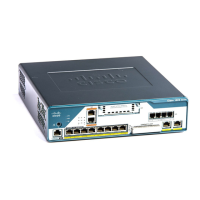Mode :T1, CEM Mode: T1-CESoP
Controller state: up, T1/E1 state: up
Idle Pattern: 0xFF, Idle CAS: 0x8
Dejitter: 5 (In use: 0)
Payload Size: 80
Framing: Framed (DS0 channels: 1-10)
CEM Defects Set
None
Signalling: No CAS
RTP: No RTP
Ingress Pkts: 203997 Dropped: 0
Egress Pkts: 203999 Dropped: 0
CEM Counter Details
Input Errors: 0 Output Errors: 0
Pkts Missing: 0 Pkts Reordered: 0
Misorder Drops: 0 JitterBuf Underrun: 0
Error Sec: 0 Severly Errored Sec: 0
Unavailable Sec: 0 Failure Counts: 0
Pkts Malformed: 0 JitterBuf Overrun: 0
Generated Lbits: 0 Received Lbits: 0
Generated Rbits: 0 Received Rbits: 0
Generated Mbits: 0 Received Mbits: 0
Troubleshooting T1/E1 Controllers
You can use the following methods to troubleshoot the T1/E1 controllers:
Running Bit Error Rate Testing for SAToP
Bit error rate testing (BERT) is supported on T1/E1 interfaces. You can run BERTs on 16 controllers out of
48 T1/E1 controllers at a time.
The interface module contains onboard BERT circuitry. With this, the interface module software can send
and detect a programmable pattern that is compliant with CCITT/ITU O.151, O.152, O.153 pseudo-random
and repetitive test patterns. BERT allows you to test cables and signal problems in the field.
When running a BERT test, your system expects to receive the same pattern that it is transmitting. To help
ensure this, two common options are available:
• Use a loopback somewhere in the link or network
• Configure remote testing equipment to transmit the same BERT test pattern at the same time
The following keywords list different BERT keywords and their descriptions.
Table 1: BERT Pattern Descriptions
DescriptionKeyword
Repeating pattern of ones (...111...).1s
Pseudo-random test pattern that is 2,048 bits in length.2^11
48-Port T1/E1 CEM Interface Module Configuration Guide, Cisco IOS XE Fuji 16.7.x (Cisco NCS 4200 Series)
7
Configuring T1/E1 Interfaces on 48-Port T1/E1 Interface Module
Troubleshooting T1/E1 Controllers

